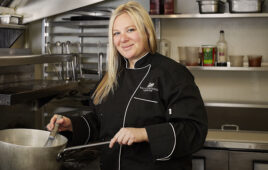Penelope Wong, Executive Chef of Glenmoor Country Club (Cherry Hills Village, Colo.), believes thinking outside the box is crucial to club food and beverage operations, especially in the new year.
Happy New Year.
For me, those three words trigger not only a period of reflection but an sense of hope for what the New Year may bring. In my reflections, I think about the accomplishments and growth I’ve made in my career. I think about the people who have helped influence and continue to inspire my growth—these people are my network of support.
As a creature of habit, every January I take care of all conference registrations for myself and my team. I’ve just completed registrations for both the CMAA conference as well as C&RB’s Chef to Chef Conference. As I was going through the registration process, I was remembering back to when I first attended the Chef to Chef Conference as a chef presenter three years ago.
As a happily self-appointed BOH individual, I was reluctant to act as a chef presenter. But I must admit, it was one of the best things I could have ever done for my career. To my disbelief, my presentation impacted other club chefs. I was approached by many other chefs that I, myself, had looked up to; many of them thrilled with the takeaways from my presentation. To my very pleasant surprise, my own takeaway from the other chef’s presentations was overwhelming! Walking away with the knowledge of new menu ideas and techniques that were being implemented in clubs across the country was invaluable. It was also an incredibly rewarding experience for me to be able to expose my sous chef to such a wide array of education that I could not provide for him within the walls of our clubhouse. We returned to our club with rejuvenated ideas that we could introduce into our own operations from banquets to member dining outlets to events.
Ultimately, I survived speaking in front of more than 300 Executive Chefs from clubs all over the country. But more importantly, the chefs I met and befriended since my first conference have become an integral network of support for me. To this day, the email chains that go back and forth between myself and this awesome network of professionals are educational, insightful, hilarious, abrasive, genuine, offensive, nurturing and always helpful.
I am very much looking forward to this year’s conference (see the agenda here) and to reconnect with many of my friends and colleagues and to learn something new to further both myself and my club’s dining operation.
If you’re on the fence about whether or not to come to the Chef to Chef Conference, check out this video from last year’s conference in San Diego (that’s me, moderating one of the Chef to Chef Live sessions right around the 1:35 mark!) and let me give you a little behind-the-scenes look at the kind of content you’ll expose yourself and your staff to. This is my presentation from my time as a chef presenter.
High-Quality, Exciting and Creative Club Fare That’s Not Pretentious; Ethnicity and Fusion, Healthy Trends
It’s been my experience that country club cuisine is often pigeonholed as boring, continental, classic; traditional. Getting away from this stereotype was the first thing I knew I needed to accomplish as Executive Chef of Glenmoor Country Club in Cherry Hills Village, Colo.
Fortuitously, there has been a growing curiosity in street foods and food trucks, resulting in a worldwide globalization of cuisine. So much so that even Hollywood is taking a piece of the pie. Amazingly, the foods I grew up with are finding their way into America’s test kitchens, onto the pages of trusted food publications and all over the likes of the Food Network, the Travel Channel, and even onto the big screen in movie theaters. From the movie, “Chef,” to “The Great Food Truck Race,” the foodies of the world are becoming more and more educated and intrigued by the products coming out of these mobile kitchens.
“Street foods” is a common term we hear so often these days; it is one that spikes interest in trying new and different foods. For foodies, “street foods” is a term synonymous with ethnicity, authenticity, simplicity, real and veritable. For us cooks, “street foods” represent sweat, equity and love. In short, “street foods” are items that are intended to truly depict the region showcased; a far cry from any five-star, white-table-cloth, wines-by-the-bottle establishment. Some might think that street foods and country club cuisine are an oxymoron, my members disagree. I’ve been with Glenmoor CC since 1998; of the many changes the club has gone through over the last 17 years, both physically and demographically, the change in the overall dining culture has been remarkable.
When I was hired as a pantry cook in 1998; the cuisine was basic, standard, continental country club cuisine. The menu was made up of Cobb salads, club sandwiches, grilled steaks with classic sauces, pastas and salmon fillets. Although I grew up a Denver native, this was immediate culture shock for me. The foods I grew up with were explosive with flavor, spice, wow and ick all at the same time. Foods like curry crab, spicy pork stuffed tapioca, rice porridge with fermented bean curd, pigs feet slow simmered with rice wine and sweet soy and spicy Thai papaya salad.
Although the assumption was that the cuisine I knew and loved and grew up with was nowhere near the unspoken caliber in this type of arena, I immediately jump started a dramatic change incorporating as many of the dishes and ingredients I grew up with onto as many menus as I could possibly get away with. Daily specials became and still are my testing grounds to see how far I can push the membership into trying new items. I started infusing simple ingredients into comfort items- a chicken pot pie infused with fresh ginger and shiitake mushroom, pasta noodles incorporated with steak, purple basil, mirin and sesame; a twist on a classic steak sandwich with Thai chilies and galangal became an instant hit. I was hell bent on re-training the members’ thoughts on what country club food could be rather than should be. The overall response and support from the membership has been tremendous. We have trained the membership to the point where, nowadays, it is not uncommon to have special requests come in for items like stuffed tofu in oyster sauce, Thai pumpkin curry and ramen noodle bowls. All of which have been featured as daily specials. As a result, with the diversity offered in our F&B program, we set ourselves apart from other club cuisine in neighboring cities.
Along with daily specials, wine dinners became another opportunity for me to step out of the box. I took even bigger risks when writing wine and food pairing menus. In my opinion, you can absolutely test the limits when pairing food with wines. Some of the more non-traditional pairings I’ve executed include a Thai cellophane noodle salad with snow crab and dried shrimp paired with a sauvignon blanc, miso glazed Japanese eggplant paired with a malbec and a curried butternut squash shooter with praline-popcorn paired with a chardonnay.
In 2006, I paired lamb in a chocolate mole sauce and smoked trout aioli with a 1982 Rioja Gran Reserva. Brett Zimmerman, a master sommelier in Colorado got wind of this pairing and his response was, “WTF? is she thinking??” Call it a coup, but it paired perfectly and the wine rep who attended the dinner was completely blown away. When he later confessed his response to the master sommelier, he was speechless. With each successful wine dinner, I became more and more daring, going as far as pairing items known as peasant foods in some countries with Vintage Barolos. Since stepping out of the box with our wine dinners, we successfully sell out of each wine and food pairing event we offer, including monthly wine and food pairings for our chef’s table seating.
Currently, I run an all day menu that can be described as contemporary global fusion. I take into account the importance of maintaining traditional standbys as well as incorporate new and innovative ideas into items that become equally as important signature dishes. On the same one page menu, I have a signature noodle bowl (which has been on the menu for the last 14 years) and a spicy Thai flavored angry shrimp that are listed alongside the likes of the famous Cobb salad and club sandwich; as well as the ever popular burger and filet. Although the burger will always be one of the top sellers at the club, more notable is the request for the spicy ginger soy glazed edamame as the chosen side item. Another signature, Diver Scallops in Avocado Tamarind Glaze with Coconut Steamed Rice and Crispy Spinach, has been a long time favorite as a weekly spotlight for 6+ years now. We offer a turkey burger on our regular menu that we infuse with Thai flavors: lemongrass, mint, purple basil, chili, kaffir lime and cilantro. We serve it on a brioche bun with a cranberry chutney; there are days when it out sells the traditional burger.
I believe thinking outside the box is crucial to club food and beverage operations, especially these days. With the ever increasing boom in new restaurant concepts popping up all over the country and the fortuitous trend in ethnicity and fusion concepts nationwide, I continue carte blanche in my kitchens to try anything and everything. I make it a personal goal to offer more than what some of the hottest trending restaurants in downtown Denver are trying—and we’ve seen tremendous success with our concepts in cuisine and dining. We have been blessed with a very active participation from our membership. Year after year, increasing cover counts rival those of trending restaurants. To date, our busiest dinner service hosted 374 covers in a la carte on a Wednesday night. Over the last few years, the food and beverage program at Glenmoor has become one of the more important deciding factors as well as a key marketing piece for potential memberships as well as memberships sold. Within just the last four years, we have seen food and beverage volume nearly double in annual revenues.
Never having had any real formal training in this arena, other than growing up with a deep love of food, it’s been my saving grace to revert back to my roots. When I was first offered the position of Executive Chef, I was still quite a deer in headlights. When it came to my first menu change, my first wine dinner as Executive Chef, my first Board Dinner, I reverted back to what I knew—the foods I knew and loved and grew up with. To my pleasant surprise, ethnicity in cuisine became exotic, cool and favored.
My father passed away recently, and in the words of Thai Buddhist monks during one of the prayer services, “Live well, eat well, die well…”




